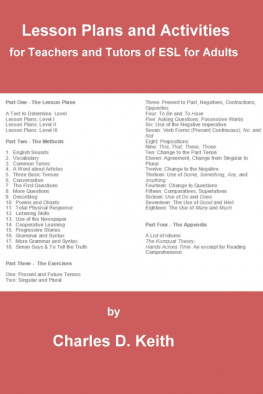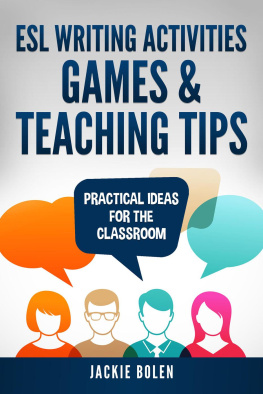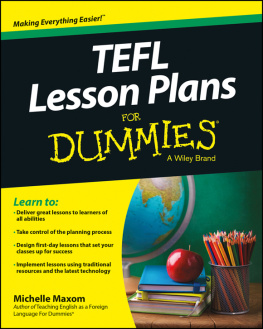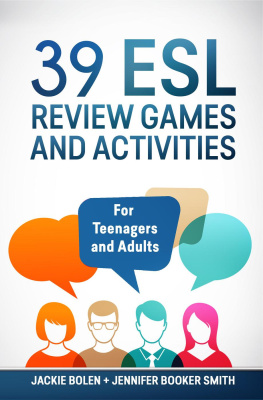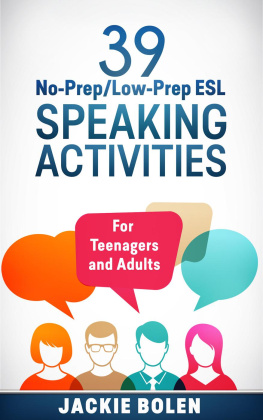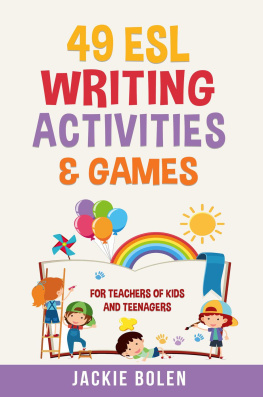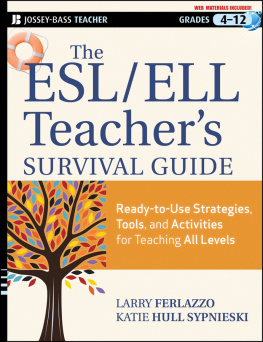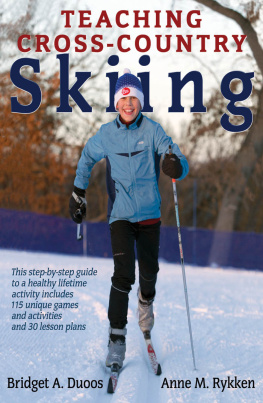Lesson Plans andActivities
for Teachers and Tutors ofESL for Adults
by
Charles D. Keith
Published by InstructionalSystems at Smashwords
Copyright 2014 by Charles D. Keith. Limitedpermission to copy portions of this work for instructional purposesat a single instructional site is extended to the purchaser by theauthor and Instructional Systems, the sole publisher of this ebook,at the time of purchase as part of the purchase agreement.
This ebook is licensed for your personal andprofessional use and enjoyment only. This ebook may not be re-soldor given away to other people. If you would like to share this bookwith another person, please purchase an additional copy for eachrecipient. If you are reading this book and did not purchase it, orit was not purchased for your use only, then please return to yourfavorite ebook retailer and purchase your own copy. Thank you forrespecting the hard work of this author.
InstructionalSystems
http://www.instructionalsystems.org
Table of Contents
Introduction
This guide offers some ideas for experiencedteachers of English, and it will serve well as a menu of lessonsand activities for those tutors or teachers of English who areentering the ESL classroom with little or no experience. The guideis arranged in sections. At the beginning, you will find a set oflesson plans. These plans are intended to serve as suggestionsonly. They will help you get off to a running start. Following theplans, you will find a series of methods. The lesson plans arekeyed to the method sheets by method number. The next sectioncontains a set of grammar exercises. The last section in the bookconsists of an appendix containing a play, a reading selection, andseveral other useful bits of information. All of this material isreferenced in the lesson plans or in one of the method sheets. Themethod sheets also contain examples of the types of drills andgames that will help you implement the plans.
The following is a list of suggestions that willhelp to make your teaching experience a pleasant success.
1. Be prepared. Plan your lessons and youractivities in advance.
2. Keep it simple.
3. Have backup plans and materials ready just incase you find that your students are already familiar with thematerial you had planned to present.
4. Teaching is as much an art as it is ascience; therefore, each teacher and tutor is justified in usingthose methods with which he or she is most comfortable.
5. Be flexible.
6. Enjoy yourself.
7. Speak slowly and clearly. Don't forget tosmile.
8. Learn the names of your students (work onpronouncing them correctly) and use them often!
The suggestions presented here are not allinclusive. Ideas that the individual tutor or teacher chooses totry may be as valid as any presented here.
Part One: the Lesson Plans
A Short Testto Determine Level
Your students maybe grouped by ability level before you are introduced to them. Ifthey are not, the following oral quiz will enable you to place themat something approximating the correct level. Normally, studentsare divided into four levels, but for our purposes, this test isset up to identify only three. If a fourth level appears desirable,it should be placed between the second and third levels. Pleaseunderstand that this is a cursory method only. It is included herein case you are presented with a mixed group that you find you haveto break into more manageable levels.
The quiz is to be given orally in order toexpedite the testing process. Mark the responses and score thequizzes as you give them.
If you choose to use this quiz, use it as both apre-test and a post-test. Compare the differences.
To score the test, circle either OK or NOT OKaccording to the students' answers.
1. Hello. How are you? OK NOT OK
2. My name is _______. What's yours? OK NOTOK
3. Where do you live? OK NOT OK
4. How old are you? OK NOT OK
5. Stand up, please. Sit down, please. OK NOTOK
6. Do you like television? OK NOT OK
7. Give me your pencil, please. OK NOT OK
8. Tell me about your family. OK NOT OK
9. What day is today? OK NOT OK
10. Please count to thirty. OK NOT OK
Zero to three OK responses equals a low level ofability .Four to seven OK responses equals a medium level ofability Eight to ten OK responses equals the highest level ofability (for this test). It's a good idea to record the students'scores and keep them for future reference.
Five Day Lesson Plans
(Each lessonis for a one hour period)
Level One, Lesson One
OBJECTIVE:To familiarize the students with the sounds of English and withsome basic vocabulary.
MATERIALS: Chalk, Chalkboard, Handouts, Nametags
REFERENCES Methods 1-3
PROCEDURE: Introduce yourself to the class. SeeCommon Terms . Make name tags and pass them out to the classmembers. Begin greetings. Refer to Methods 1 & 2.
EVALUATION: Quiz orally and informally.
Level One, Lesson Two
OBJECTIVE: To familiarize students with simplecommands. At the conclusion of the lesson, each student will beable to understand and give at least ten common commands.
MATERIALS: Chalk/chalkboard
REFERENCES: Methods 5, 11, 14, 16, &Exercise Four
PROCEDURE: Begin with a review of the materialcovered on day one. Then demonstrate the following commands: "Standup," "Sit down," "Come here," "Open the door." For additionalcommands, refer to Methods 11 and Exercise Five. For method to beused, refer to Method 11. Introduce the forms of the verb to be.See Methods 5 and 16. Organize a line-up. See Method 14. Try towork only in the present tense.
EVALUATION: A successful line-up will serve asan indicator of the understanding of the spoken commands.
Level One, Lesson Three
OBJECTIVE: To familiarize students with thecommon methods of forming questions. Students will also learn thecounting numbers to one hundred. Students will expand theirvocabulary with the vocabulary suggestions found in the Methodssection.
MATERIALS: Chalk/chalkboard
REFERENCES: Methods 7 & 8, & ExercisesFourteen & Sixteen
PROCEDURE: Begin with a brief review of thematerial covered during the last two lessons. Introduce the "wh"words: who, what, where, when, etc. and give examples oftheir usage. Give particular attention to the subject/verb reversal(Methods 7 & 8). Demonstrate the position of the verb as thefirst word in a question. For the method to be used, refer toMethod 7. Give attention to the verb do. At this point, it's okayto introduce simple questions framed in the past as they are socommon. For example, "Did he....?" (Exercise Sixteen). the "wh"words: who, what, where, when, etc. and give examples oftheir usage. Give particular attention to the subject/verb reversal(Methods 7 & 8). Demonstrate the position of the verb as thefirst word in a question. For the method to be used, refer toMethod 7. Give attention to the verb do. At this point, it's okayto introduce simple questions framed in the past as they are socommon. For example, "Did he....?" (Exercise Sixteen).
EVALUATION: Give a short written quiz asfollows. Write a few simple statements on the board such as, "Youare a good student." Ask the students to change the statements toquestions noting the subject/verb reversal. For example, "Are you agood student?" Write the answers on the board and ask the class tocorrect any mistakes they might have made. Then, as an additionalreinforcement, ask those who would like to, to read their answersaloud. Reverse the procedure and ask the questions first having thestudents give their answers.
Level One, Lesson Four
OBJECTIVE: To review the use of the verb to beand to expand vocabulary
MATERIALS: Chalk/chalkboard
REFERENCES: Methods 1, 3 & 5.
Next page
